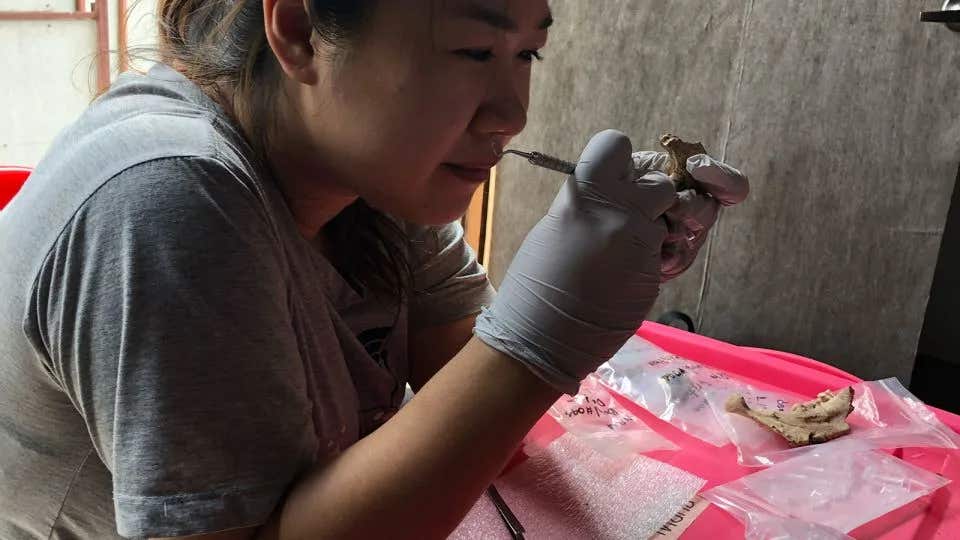Ancient tooth fossil reveals humans have been getting high for over 4,000 years
The findings highlight dental calculus analysis as a revolutionary tool for uncovering hidden ancient practices and traditions.

Co-author Charmsirin Devanwaropakorn carefully removes ancient dental calculus during fieldwork at the Nong Ratchawat site. (CREDIT: Piyawit Moonkham / Frontiers)
Betel nut chewing is more than just a simple habit. Throughout history, communities across Southeast Asia have used these nuts socially, spiritually, and medicinally. Wrapped in betel leaves and combined with additives like limestone paste, betel nuts produce feelings of alertness, relaxation, and euphoria.
Despite its long history, this practice has faded in recent decades due to health concerns. However, new research has discovered fascinating evidence of ancient betel nut use hidden deep inside teeth.
Ancient Clues from Bronze Age Thailand
Chewing betel nuts typically leaves reddish-black stains on teeth, a clear sign of regular use. But archaeologists noticed something unusual at Nong Ratchawat, a Bronze Age site in central Thailand. Out of 156 burials, no teeth showed staining or wear typically linked to chewing betel nuts. Researchers wondered if these early Southeast Asian residents had a different method of consuming betel nuts or if evidence had simply faded over time.
To find out, Dr. Piyawit Moonkham from Chiang Mai University and Dr. Shannon Tushingham from the California Academy of Sciences turned to an unlikely source: ancient dental plaque. Known scientifically as dental calculus, this hardened plaque preserves tiny traces of food, bacteria, and even psychoactive substances. It can store chemical markers for thousands of years.
The team analyzed calculus samples from six burials at Nong Ratchawat, dating back about 4,000 years. They hoped this microscopic evidence could reveal hidden practices invisible to traditional archaeology.
Turning Plaque into Proof
Before testing ancient samples, researchers needed to confirm their detection method. Using fresh betel nuts, leaves, and other ingredients, they made their own chewing mixtures. They even replicated the chewing process by grinding these ingredients with saliva.
Related Stories
- Scientists grow real teeth in the lab - replacing fillings and implants
- Lifechanging drug regrows teeth in humans
- Researchers reveal the cardiovascular risks of marijuana use
“Sourcing materials and experimentally ‘chewing’ betel nuts to create authentic quid samples was both a fun and interesting process,” Moonkham said.
The scientists then used liquid chromatography-mass spectrometry (LC-MS) to identify chemical signatures of betel nut components in these modern mixtures. Specifically, they searched for compounds called arecoline and arecaidine, known psychoactive chemicals found naturally in betel nuts.
With this successful validation, researchers moved to the real challenge: analyzing 4,000-year-old calculus samples from Nong Ratchawat. The results were surprising.
Three dental calculus samples, all from one burial—a woman identified as Burial 11—contained clear evidence of betel nut compounds. These traces represent the earliest direct biomolecular evidence for betel nut chewing in Southeast Asia.
“We identified plant derivatives in dental calculus from a 4,000-year-old burial at Nong Ratchawat,” Moonkham said. “This is the earliest direct biomolecular evidence of betel nut use in Southeast Asia.”
This discovery is groundbreaking because it proves ancient people chewed betel nuts even when traditional archaeological markers—like stained teeth or nut fragments—were absent.
“In essence, we’ve developed a way to make the invisible visible—revealing behaviors and practices that have been lost to time for 4,000 years,” Tushingham explained.
Invisible Evidence and Cultural Significance
The absence of tooth staining puzzled the researchers. If betel nut chewing was common, why weren’t teeth stained? They proposed several explanations. Perhaps ancient chewing methods were different, or regular tooth cleaning removed stains. Another possibility is that staining simply didn't survive thousands of years underground.
Though only one individual’s plaque showed clear evidence, it didn't necessarily suggest special treatment or elevated social status. Still, the presence of stone beads among the burial goods hints at some personal importance.
Future studies of more burials could clarify who chewed betel nuts and why. Researchers believe dental calculus analysis can revolutionize understanding of ancient human behavior by revealing invisible practices.
“Dental calculus analysis can reveal behaviors that leave no traditional archaeological traces, potentially revolutionizing our understanding of ancient lifeways and human-plant relationships,” Tushingham said.
Tradition versus Modern Concerns
Despite modern health warnings about betel nut chewing, its cultural roots run deep. For thousands of years, people throughout Southeast Asia chewed betel nuts wrapped in Piper betle leaves. Ingredients varied by region but typically included limestone paste and sometimes tobacco. The resulting juice, typically spat out but occasionally swallowed, produces relaxation, warmth, and alertness.
Recent interviews in rural Thailand revealed traditional beliefs that chewing betel nuts prevents tooth decay, heals wounds, and wards off certain ailments. The dark tooth staining itself is considered a mark of beauty or status in many communities.
Yet, during the 1940s, modernization policies sharply reduced public chewing, particularly in urban areas. Contemporary public health perspectives generally treat betel nut chewing as unhealthy, overlooking its deep cultural importance. As Moonkham emphasized, recognizing the historical context is vital.
“Understanding the cultural context of traditional plant use is a larger theme we want to amplify,” Moonkham said. “Psychoactive, medicinal, and ceremonial plants are often dismissed as drugs, but they represent millennia of cultural knowledge, spiritual practice, and community identity.”
Betel Nut Chemistry and Biology
The psychoactive effects of betel nuts come primarily from the compounds arecoline and arecaidine. These alkaloids stimulate the nervous system, increasing energy and mental clarity. The nuts also contain tannins, iron, magnesium, and various oils, contributing to their medicinal properties.
Piper betle leaves, used to wrap the nut, contain another beneficial compound called hydroxychavicol. This chemical is traditionally used to treat dental infections and fungal diseases.
Despite health concerns, betel nut chewing remains a cherished tradition in many rural Southeast Asian communities, symbolizing hospitality, friendship, and shared identity.
Looking Forward: New Methods, Old Traditions
This pioneering study at Nong Ratchawat demonstrates the remarkable potential of dental calculus analysis. By identifying hidden biochemical markers, researchers can uncover practices previously invisible to archaeology.
Expanding these methods to other sites may soon reshape understanding of how ancient humans used psychoactive plants. This approach also highlights the importance of preserving traditional knowledge.
“Archaeological evidence can inform contemporary discussions by honoring the deep cultural heritage behind these practices,” Moonkham concluded.
Research findings are available online in the journal Frontiers in Environmental Archaeology.
Note: The article above provided above by The Brighter Side of News.
Like these kind of feel good stories? Get The Brighter Side of News' newsletter.



